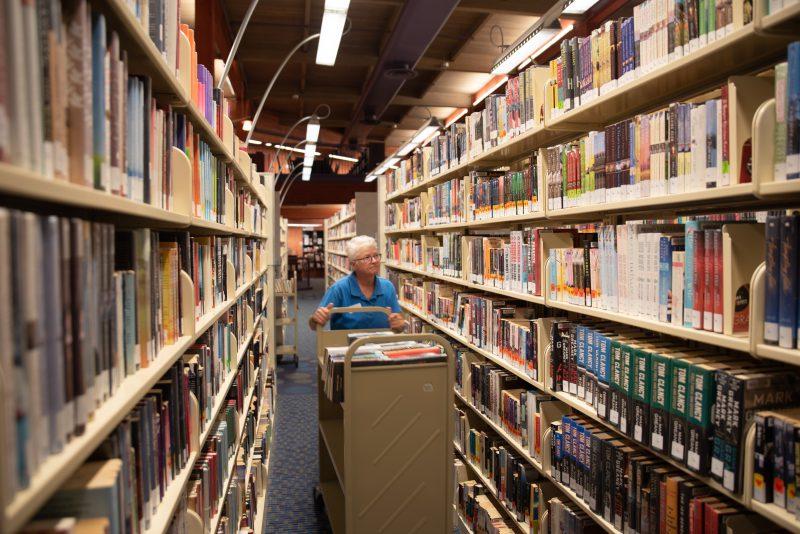The hum of the air conditioning. The bustling of homework papers. The turning wheels of the cart carrying the yet-to-be shelved books.
These are the typical sights and sounds of a library, yet with constantly innovated technologies, re-thinking library spaces is certainly in the near future.
Kristy Toplikar, Daniel Boone Regional Library’s (DBRL) Youth Services Librarian, believes its mission addresses the purpose a library serves. The library strives to be a central part of the community and a dependable resource, while also connecting people to opportunities that bring them information.
“Our library serves many, many purposes from teaching early literacy skills to little ones to helping teens and adults find jobs and everything in between,” Toplikar said. “DBRL strives to be the glue that connects our patrons to the information they seek and the community they live in.”
DBRL achieves this goal by lending out much more than books. It offers audiobooks, playaways, magazines, DVDs and CDs. In 2017, Toplikar said there was an average weekly circulation of 28,211. This number only includes physical items checked; digital checkouts and those from other branches are listed separately, Toplikar said. In addition to providing materials, employees give their expertise.
“Want help finding out more about your family history? We have classes for that,” Toplikar said. “Need help learning how to sell items online? We have a class for that too. We host trainings on a variety of different subjects, according to our community’s needs.”
But in an age of advanced technology, the attention of customers is “constantly divvied among dozens of devices all bearing different distractions,” a Forbes article said. This new trend of digital devices can explain the start up of brands such as Serial Box, which mixes the best of books and podcasts to bring readers a new, convenient form of storytelling. With such advances, Toplikar said the physical library may experience less foot traffic from patrons who primarily use digital resources. Toplikar still recognizes there are individuals who come to the library for reasons other than checking out materials. This includes study rooms, computer labs or the Quiet Reading Room.
Despite technology’s effect on active engagement, Koo observes there is still a fairly large amount of people every time she goes to a library. As a result, she believes if libraries are accessible, they’ll always be used to some extent.
“First, people don’t just go to the library for books,” Koo said. “Second, a lot of people I know that read hate e-books because of the strain at looking at a screen for a really long time. Also, a lot of the time, I think having a physical book feels [like] more of an accomplishment if you finish. Between electronics and a physical book, there will be always people that want the latter even if there are people that stop going because of the new options.”
Like Koo mentioned, there will always be people that still want the option of a physical book. Media center specialist Dennis Murphy said fiction, is still thriving. He noted that he doesn’t really notice fewer students coming in to the library either, although it may seem that way just because the library stopped checking out laptops, allowing greater pedestrian flow in the media center.
“In fact, a lot of libraries provide computer and internet access and have modernized in order to accommodate the decline in checking out books,” Scoville said. “I think that many people just don’t have the time to make it out to the library.”
From her perspective behind the service desk, Toplikar believes libraries will both stay the same and change in the future. Core values, especially, tend to stay consistent.
“We want to serve our communities in the best possible way, providing resources and services to assist with lifelong learning and education,” Toplikar said. “However, I see a lot of changes ahead in the future of libraries. As the world changes, libraries change to keep up.”
These changes are often based off of recent interests. For instance, Toplikar said she has seen a lot of attention in STEAM (science, technology, engineering, art, and mathematics).
“Before the end of the year, we will be rolling out STEAM kits for checkout, which will include tech that will help youth explore subjects like engineering, coding and robotics,” Toplikar said. “We’re always on the lookout for nontraditional items to check out to help our community grow and thrive.”
Librarian’s dedicate the vast majority of their time figuring out how to give library patrons the best possible information and experience, Toplikar said. Whether this means identifying the right book on the shelf or simply going to find a quiet space, it may be safe to say that despite the way technology is changing the future, libraries will stick around for some time.
“Libraries should be valued because your library values you,” Toplikar said. “People come [to the library] when they find themselves suddenly homeless or in a hard situation, and we provide them with a safe space to be while giving them community contacts to help them. Or people come in simply because they are bored and want a suggestion from a librarian for their next great read. Whatever the reason, we’re here to help.”
Do you still visit the public library to check out paper copies of books? Let us know in the comments below.





















































































